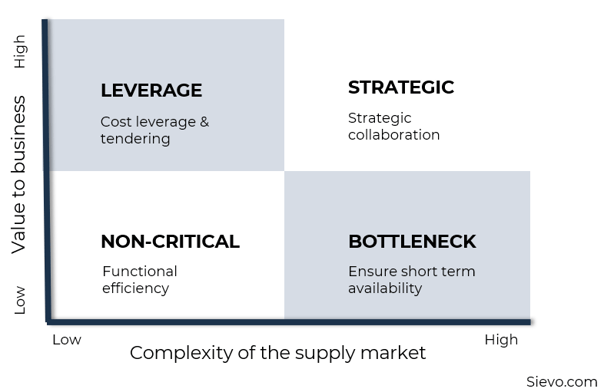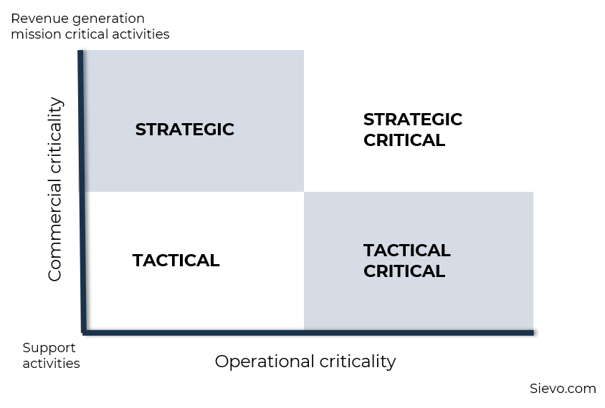A category strategy defines the category's vision, mission, and deliverables to perform optimally.
Category management in procurement is a strategic approach to segmenting their spend into groups of products and services that are similar in nature and characteristics.
This practice has been around in procurement for more than 30 years. Every few years, someone floats the question, “is category management dead?”. Some would say yes, but the real answer is no- it constantly evolves.
Category management was initially launched as a project-based approach to managing the sourcing of goods and services. The aim was, and is, to deliver value to the organization beyond just negotiating better prices. It enables harnessing the benefits of scale and scope.
This article will examine the criticality matrix and how it changes our assumptions about category management.
Changing strategies
It is generally accepted that category management forms the basis for successful strategic sourcing initiatives.
The general principle is to group goods and services with similar characteristics using a global standard such as UN Standard Products and Services Code (UNSPSC) or an internal taxonomy.
This thinking has not changed. The basics need to be in place before attempting advanced strategies. There is no one correct solution to categorization. It depends on the industry, procurement’s organizational maturity, structure, governance, spend profiles, and the external marketplace.
A manufacturer of packaging solutions will categorize differently from a software company. One thing is for sure. It is not an event but a living process. We can see that advances in technology are impacting category plans.
As requirements and market conditions change, category strategies must be reviewed annually.
Category planning
There are some prerequisites for successful category management. #1 is to have a category plan. Not just any plan: one that is developed and accepted by all stakeholders.
The category plan should be based on:
-
An in-depth understanding of the organization’s business strategy so that the categories are aligned with wider goals.
-
Continuous analysis of spend, market data, and benchmarks to identify additional improvement opportunities.
-
Continuous price analysis on local and international markets and monitoring of trends in the category.
-
Capturing supplier performance data to drive quality and service improvements.
-
Tracking of actual savings achieved through substitutions, better compliance, and negotiations.
-
On-going stakeholder discussions and reviews to ensure that all affected parties and users are involved in decisions within the category.
Category spend analysis
The backbone for category planning and strategy work is spend analysis. Spend classification and supplier segmentation provides visibility on category spend trends and where sourcing and development efforts. They should be focused on the highest return on investment.
Category spend analysis can reveal the potential for consolidation, best areas for tendering, payment term optimization, purchasing process improvement, or contract coverage issues.
With sophisticated spend analysis software, you can identify category and supplier segment opportunities.
Stakeholder management for category success
Category management is relationship management as much as it is data-driven leadership.
Modern category management involves partnering with internal stakeholders and end-users as early as possible. Failure to do this can derail future projects. Stakeholders are often referred to as “internal customers” or “the eyes and ears” of the market.
They can provide you with a unique supplier and market knowledge, and relevant insights that might be time-consuming or impossible to obtain otherwise. In return, you are expected to understand stakeholder requirements and consider those in your category planning and sourcing specifications.
Formally documenting category plans with your stakeholders ensures mutual commitment and focus. Plans drive the correct behavior and direct the effort towards achieving the desired results. For instance, you might have targets for longer payment terms or improving contract coverage within the category.
These initiatives are hard to implement alone and your stakeholders are your spokespersons for the wide group of suppliers.
Documentation includes alignment and signoff from stakeholders. A well-thought-out and successfully implemented category plan delivers value, efficiency, quality, sustainability, and innovation, as well as mitigating risk.
Criticality matrix approach
The International Institute for Advanced Purchasing and Supply (IIAPS) makes the case for a "paradigm shift" in current thinking about how to undertake category management and develop sourcing strategies.
Traditional approch
Traditional approaches to identifying opportunities are often based on the Kraljic matrix or a similar model where the focus is on clearly identified strategic goods and services like this:

These basic categories are often used in simple supplier matrix and pyramid techniques.
IIAPS promotes a more sophisticated understanding of the different types of categories of supply that must be managed by organizations.
Criticality approach
In their White Paper: Power Positioning & Sourcing Portfolio Analysis: Techniques for Effective Category Management & Strategic Sourcing, one of their less complex and more practical approaches takes the Strategic quadrant and offers a four-way classification based on criticality.
Here's what each quadrant means:

Strategic Critical
A strategic critical category will have a significant impact on both operations and the commercial/mission-critical goals of the organization.
The total level of expenditure may not be high, although it often is. Such categories normally require extensive senior management attention, with the highest levels of organizational resource input in the sourcing process in terms of expenditure, time, and involvement.
Strategic
A strategic category will normally have only a relatively low impact on operational delivery, but nevertheless, impact significantly on the strategic commercial/mission-critical goals of the organization.
The total level of expenditure may not be high. Such categories do not normally require extensive senior management attention, or the highest levels of organizational resource input in the sourcing process in terms of expenditure, time, and involvement.
Tactical Critical
A tactical critical category will normally have a significant impact on operational delivery, but not on the commercial/mission-critical goals of the organization.
The total level of expenditure may be high. Such categories normally require extensive attention, but with only middle rather than senior management participation in cross-functional teams. The organizational resource input required in the sourcing process is normally not as significant as that required for strategic items.
Tactical
A tactical category will normally have only limited significance for either operational delivery or the commercial/mission-critical goals of the organisation.
The total level of expenditure will not be relatively high. Such categories normally require only limited attention, with middle and lower-level managers participating in ad hoc teams. The organizational resource input required in the strategic sourcing process is normally quite low.
Why choose the criticality approach?
Focus on operational and commercial criticality enables focusing on business requirements and continuity, instead of looking at spend and opportunity cost only.
This four-way segmentation consideration is essential because it plays a major role in identifying:
-
who will be part of the sourcing strategy team?
-
the level of engagement of stakeholders?
-
the level of time and resources that will be devoted to a specific sourcing strategy?
-
the types of value-for-money KPIs that are to be sourced?
The criticality approach guides resourcing, levels of analysis, and work scopes that procurement must engage in when developing new sourcing strategies.
The approach avoids many positioning errors made by procurement forced into making simplistic choices between categories.




